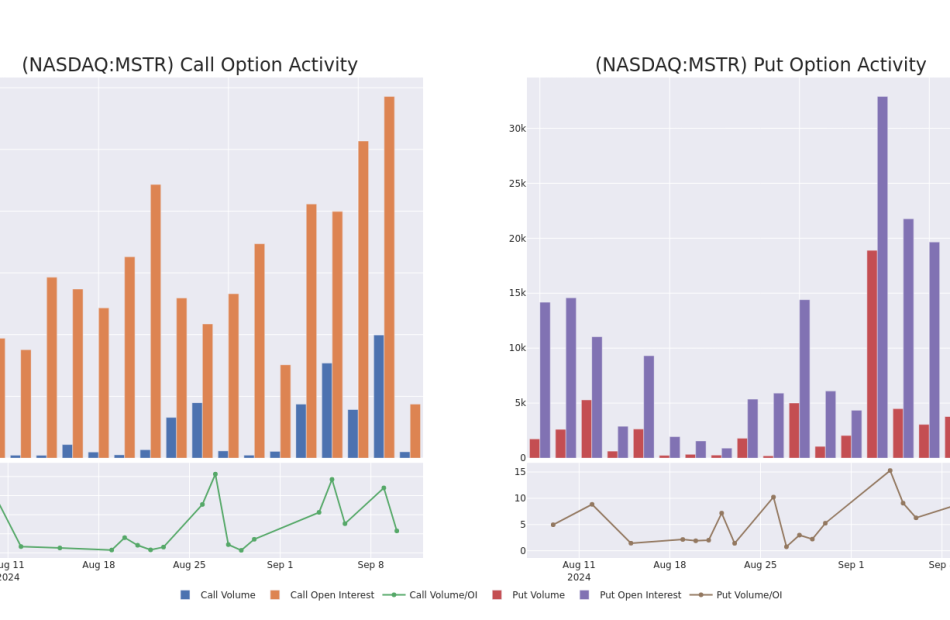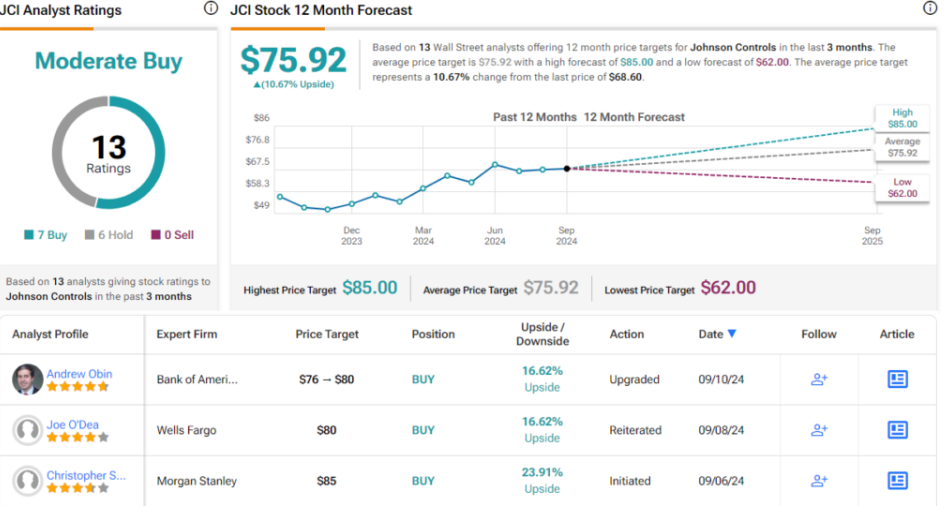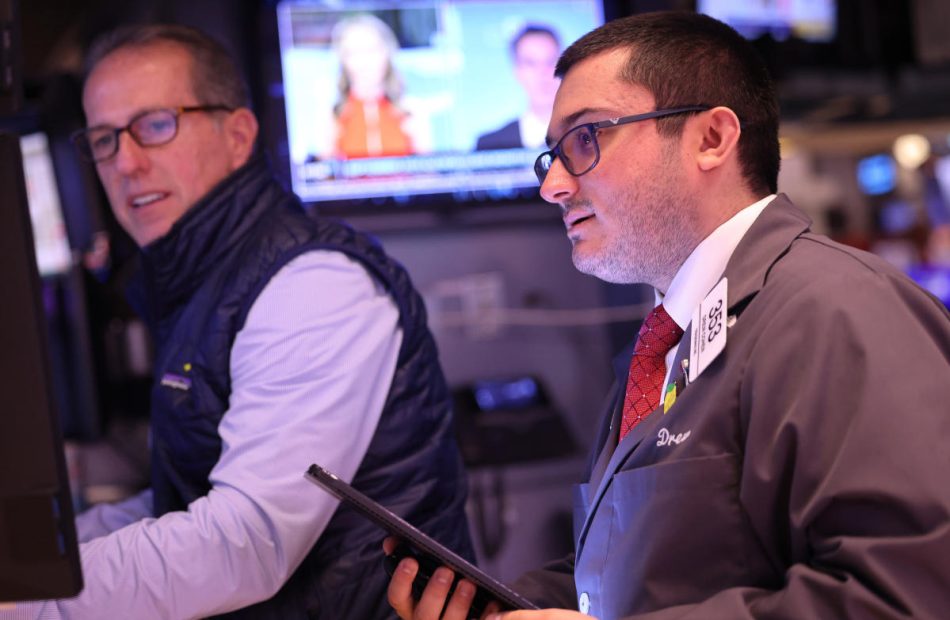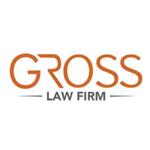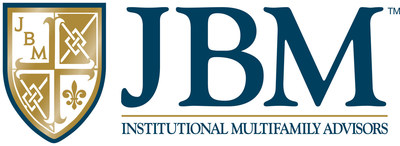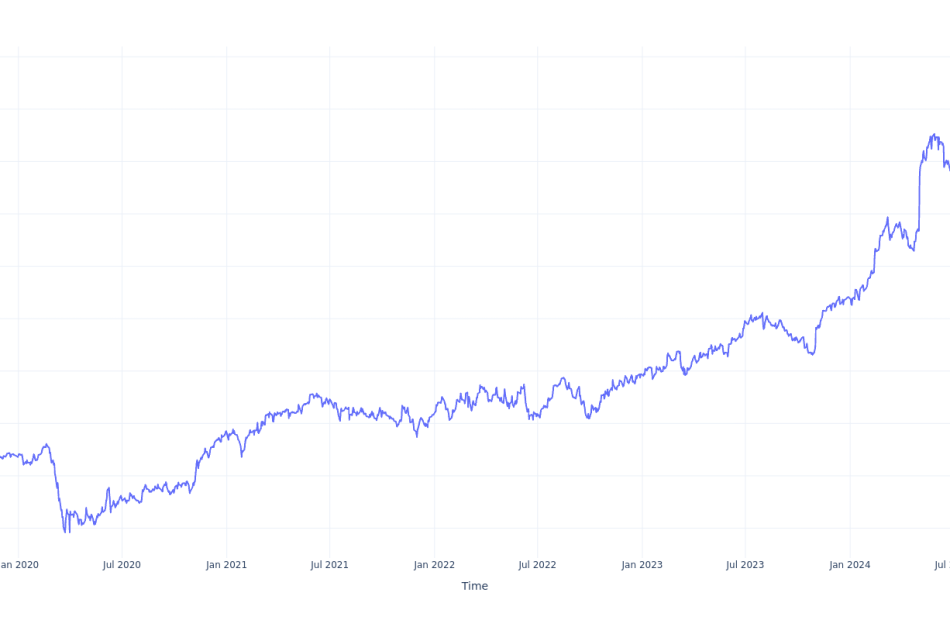Spotlight on MicroStrategy: Analyzing the Surge in Options Activity
Investors with a lot of money to spend have taken a bearish stance on MicroStrategy MSTR.
And retail traders should know.
We noticed this today when the positions showed up on publicly available options history that we track here at Benzinga.
Whether these are institutions or just wealthy individuals, we don’t know. But when something this big happens with MSTR, it often means somebody knows something is about to happen.
Today, Benzinga’s options scanner spotted 10 options trades for MicroStrategy.
This isn’t normal.
The overall sentiment of these big-money traders is split between 20% bullish and 80%, bearish.
Out of all of the options we uncovered, there was 1 put, for a total amount of $52,000, and 9, calls, for a total amount of $436,429.
Predicted Price Range
After evaluating the trading volumes and Open Interest, it’s evident that the major market movers are focusing on a price band between $30.0 and $125.0 for MicroStrategy, spanning the last three months.
Volume & Open Interest Development
Looking at the volume and open interest is an insightful way to conduct due diligence on a stock.
This data can help you track the liquidity and interest for MicroStrategy’s options for a given strike price.
Below, we can observe the evolution of the volume and open interest of calls and puts, respectively, for all of MicroStrategy’s whale activity within a strike price range from $30.0 to $125.0 in the last 30 days.
MicroStrategy Option Activity Analysis: Last 30 Days
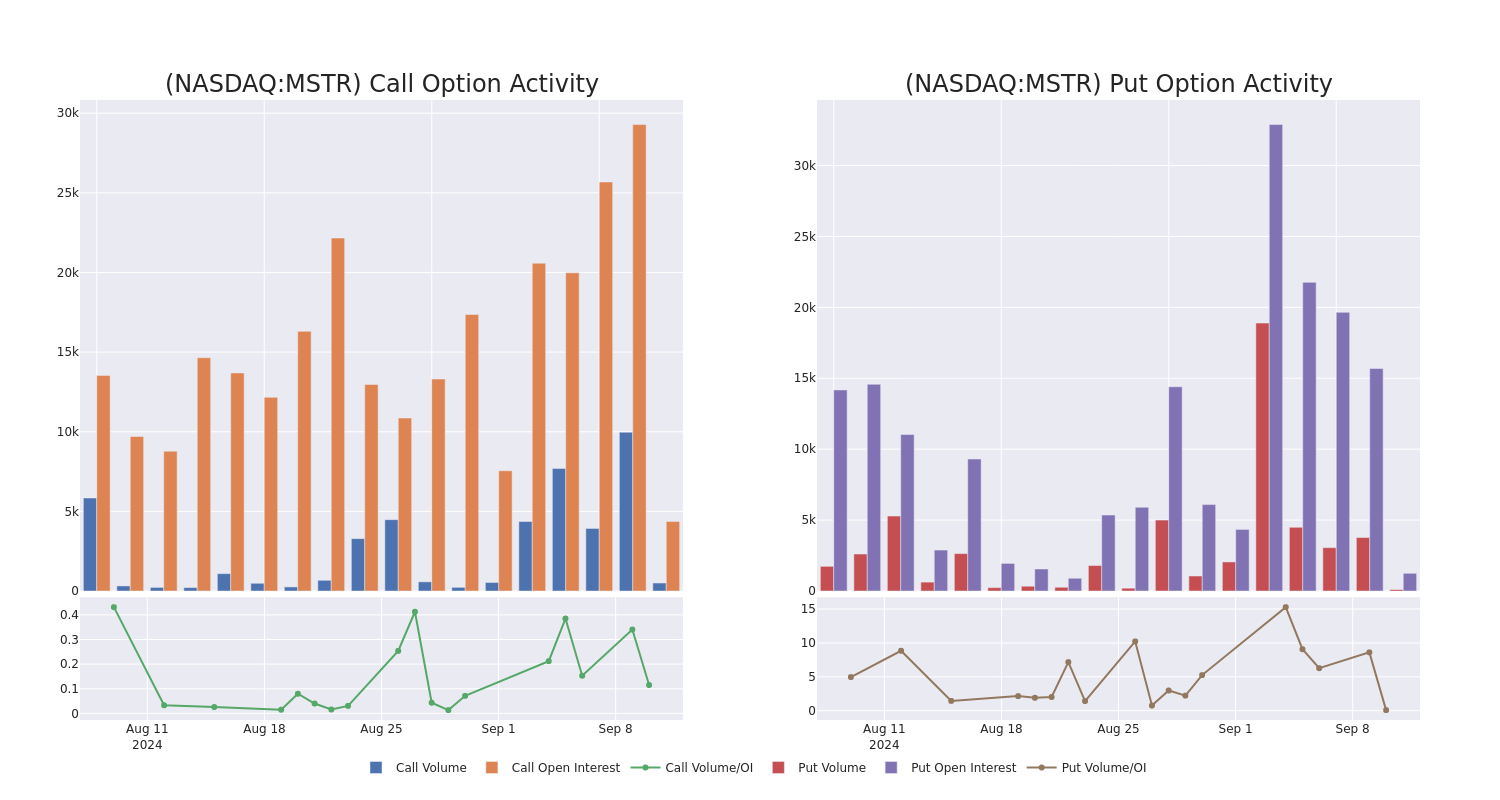
Largest Options Trades Observed:
| Symbol | PUT/CALL | Trade Type | Sentiment | Exp. Date | Ask | Bid | Price | Strike Price | Total Trade Price | Open Interest | Volume |
|---|---|---|---|---|---|---|---|---|---|---|---|
| MSTR | CALL | TRADE | BEARISH | 04/17/25 | $35.45 | $34.5 | $34.5 | $125.00 | $79.3K | 156 | 45 |
| MSTR | CALL | SWEEP | BEARISH | 10/18/24 | $14.05 | $13.35 | $13.35 | $123.00 | $62.7K | 228 | 47 |
| MSTR | CALL | SWEEP | BEARISH | 06/18/26 | $104.6 | $97.8 | $101.61 | $30.00 | $60.8K | 55 | 8 |
| MSTR | CALL | TRADE | BEARISH | 06/18/26 | $61.7 | $60.0 | $60.0 | $120.00 | $60.0K | 589 | 10 |
| MSTR | PUT | TRADE | BULLISH | 09/13/24 | $6.7 | $5.2 | $5.2 | $125.00 | $52.0K | 1.2K | 104 |
About MicroStrategy
MicroStrategy Inc is a provider of enterprise analytics and mobility software. It offers MicroStrategy Analytics platform that delivers reports and dashboards and enables users to conduct ad hoc analysis and share insights through mobile devices or the Web; MicroStrategy Server, which provides analytical processing and job management. The company’s reportable operating segment is engaged in the design, development, marketing, and sales of its software platform through licensing arrangements and cloud-based subscriptions and related services.
After a thorough review of the options trading surrounding MicroStrategy, we move to examine the company in more detail. This includes an assessment of its current market status and performance.
Current Position of MicroStrategy
- Trading volume stands at 507,928, with MSTR’s price down by -1.39%, positioned at $123.08.
- RSI indicators show the stock to be is currently neutral between overbought and oversold.
- Earnings announcement expected in 50 days.
Professional Analyst Ratings for MicroStrategy
Over the past month, 2 industry analysts have shared their insights on this stock, proposing an average target price of $170.0.
- An analyst from Barclays has revised its rating downward to Overweight, adjusting the price target to $146.
- In a cautious move, an analyst from Cantor Fitzgerald downgraded its rating to Overweight, setting a price target of $194.
Trading options involves greater risks but also offers the potential for higher profits. Savvy traders mitigate these risks through ongoing education, strategic trade adjustments, utilizing various indicators, and staying attuned to market dynamics. Keep up with the latest options trades for MicroStrategy with Benzinga Pro for real-time alerts.
Market News and Data brought to you by Benzinga APIs
© 2024 Benzinga.com. Benzinga does not provide investment advice. All rights reserved.
‘Choose Wisely’: Morgan Stanley Says Buy These Defensive, Quality Stocks
The big news recently concerned the August jobs report, which came in below expectations. The softness in the jobs market spooked investors, and market watchers are now looking to the Fed’s next meeting, and an anticipated cut in the key funds rate.
So, where does the stock market go from here? The overall trend of the past year remains bullish, and investors aren’t fleeing the market – yet. But the question remains, where should investors start putting their money? A recent report from Morgan Stanley’s chief US equity strategist, Mike Wilson, suggests buying stocks that show a combination of defensive positions and overall quality.
“Until the bond market starts to believe the Fed is no longer behind the curve (spread between 2-year yield and Fed Funds narrows), growth data reverses course and improves materially or additional policy stimulus is introduced, it will be difficult for equity markets to trade with a more risk on tone, in our view,” Wilson said. “This means valuations are likely to remain challenged for the overall index… In such an environment, quality + defensive equities should continue to show outperformance.”
The stock analysts at Morgan Stanley are following this lead, and pointing out solid defensive plays that should command investor attention going forward. We’ve used the database at TipRanks to look at the broader picture on two of these quality defensive stocks, so let’s take a dive into the details.
Johnson Controls (JCI)
We’ll start with Johnson Controls, maybe not a household name but a well-known player in the world of HVAC. Johnson Controls is a Fortune 500 name, boasts a market cap of almost $46 billion, and generated $26.8 billion in its fiscal year 2023, its most recent full fiscal year. The company has built its success on the basic necessity of the core service it provides: HVAC, fire control, and safety/security systems for commercial and office spaces.
Johnson Controls has been in business since 1885, when it was founded as an electric service provider. The company’s longevity is a distinct asset – this is a firm that knows how to adapt to changing times, and can show investors a long record of success. The company operates at a global scale, in more than 150 countries, and employs approximately 100,000 people. Johnson is known for integrating the latest technologies into its ‘smart building systems,’ including AI and machine learning, without forgetting the basics of the hands-on mechanical technology.
Earlier this summer, Johnson Controls made an important change, when it announced an agreement to sell off its Residential and Light Commercial HVAC business division. The buyer, Bosch, will acquire this segment of Johnson in a transaction valued at $8.1 billion; JCI’s consideration of the total comes to $6.7 billion. The move will turn Johnson Controls into a pure-play provider of ‘comprehensive solutions for commercial buildings.’
Also in July of this year, Johnson Controls announced the pending retirement of CEO George Oliver after 7 years in the position. Oliver will remain at the helm until a replacement chief executive is appointed, and will continue as chairman of the Board of Directors.
Turning to the financial side, we find that Johnson Controls reported a top line of $7.2 billion in its last quarter, fiscal 3Q24. This figure was up a modest 1% year-over-year, but missed the forecast by $140 million. At the bottom line, the company reported an EPS of $1.14 in non-GAAP measures, beating the estimates by 6 cents per share.
For Morgan Stanley analyst Chris Snyder, the key here is this company’s solid position in its niche, and a sound outlook going forward. As he writes, “JCI portfolio transformation brings attractive risk-reward as the company is now a pureplay provider of commercial building solutions (HVAC, Controls, Fire & Safety) – resulting in a more durable business and providing a re-rating opportunity. We see ~30% pro-forma service mix and increased exposure to industrial mega-trends (Data Center, US Reshoring) pushing the equity into a more premium comp group. While our math pegs pro-forma F’26 EPS L-MSD below existing operations, this can be offset with relatively minor cost take (~4% of divested sales). What’s left is largely unchanged EPS for a high-quality business while JCI equity continues to trade at 2-3 turn discount vs the peer group.”
These comments support Snyder’s Overweight (Buy) rating on the stock, and his price target, of $85, indicates an upside of 24% for the year ahead. (To watch Snyder’s track record, click here)
This stock sports a Moderate Buy rating from the Street’s analysts, based on 13 reviews that include 7 Buys and 6 Holds. The shares are priced at $68.60 and the $75.92 average price target implies a one-year upside potential of almost 11%. (See JCI stock forecast)
General Dynamics (GD)
The second stock we’ll look at here is General Dynamics, an aerospace and technology manufacturing company – and one of the major defense contractors working in the US economy. General Dynamics was founded in 1893 and focused on the development of submarines as the Holland Torpedo Boat Company; it provided the Navy’s first modern subs as early as 1900. Since then, it has only grown. It provided 80 submarines for the US Navy during the Second World War, and expanded into the aerospace industry after the war. It changed its name to General Dynamics in 1952, and since then, it has built a reputation as an innovator, with a hand in the development of the F-111 strike aircraft and, later, developing and building the wildly successful F-16 fighter.
Today, General Dynamics operates through four business divisions: Aerospace, Marine Systems, Combat Systems, and Technologies. The company’s highest profile products today come from the Marine Systems division, where the Bath Iron Works and the Electric Boat segments produce, respectively, the Navy’s Arleigh Burke-class destroyers and its nuclear-powered submarines. In addition, the Aerospace division includes the famous Gulfstream jets.
In recent months, General Dynamics has secured several important contracts, showing how the company remains relevant to the defense industry. It started the month of August by announcing a $174 million contract for retrofit, repair, and support of the US Army’s Stryker vehicles, and followed this later in the month with a $1.32 billion contract modification that allows it to purchase ‘long lead time’ materials for the Virginia-class nuclear submarine program. And, in early September, GD secured a $491 million modification to an Air Force contract, for the Proliferated Warfighter Space Architecture Ground Management and Integration program, ongoing in Huntsville, Alabama and Grand Forks, North Dakota.
General Dynamics last reported earnings results for 2Q24, and in that quarter, top line revenues came to $12 billion – up 18% from the prior-year period and beating expectations by $500 million. The bottom line EPS figure of $3.26, while up more than 20% year-over-year, missed the forecast by 7 cents per share.
On the balance sheet, General Dynamics finished the quarter with $1.4 billion in cash on hand – after paying out $389 million in total dividends, repurchasing $34 million worth of stock, and investing $201 million in capital expenditures. Looking forward, the company can lean on a $91.3 billion work backlog.
Kristine Liwag, one of Morgan Stanley’s 5-star analysts, covers this defense giant, and in her coverage she notes that the company has plenty of strengths: “We see GD with a premier balance sheet and strong prospects for capital return upside. A refreshed line-up of new Gulfstream aircraft coupled with strong demand for GD’s defense products (e.g., ammo, ground vehicles) together present strong earnings growth potential… We see GD entering a unique period of margin acceleration.”
To quantify her stance, Liwag rates GD shares as Overweight (Buy), and her $345 price target indicates room for a 14.5% gain in the next 12 months. (To watch Liwag’s track record, click here)
This stock has earned a Strong Buy consensus rating from the analysts, with the 16 recent recommendations breaking down to 13 Buys and 3 Holds. The stock’s $301.56 trading price and $329.13 average target price together suggest an upside of 9% by this time next year. (See GD stock forecast)
To find good ideas for stocks trading at attractive valuations, visit TipRanks’ Best Stocks to Buy, a tool that unites all of TipRanks’ equity insights.
Disclaimer: The opinions expressed in this article are solely those of the featured analysts. The content is intended to be used for informational purposes only. It is very important to do your own analysis before making any investment.
Tire Pressure Sensor and Airbag Sensor Market is Estimated to be US$ 10.63 Billion by 2034 with a CAGR of 6.7% | Fact.MR Report
Rockville, MD, Sept. 10, 2024 (GLOBE NEWSWIRE) — Based on the newly published report by Fact.MR, a market research and competitive intelligence provider, the global tire pressure sensor and airbag sensor market is evaluated to reach US$ 5.56 billion in 2024. The market is further forecasted to advance at a CAGR of 6.7% between 2024 and 2034.
Due to their widespread uses and vital role in vehicle safety, tire pressure and airbag sensors are seeing a sharp increase in demand worldwide. These sensors are now essential parts of contemporary cars because of advancements in automotive technology, which provide real-time monitoring and improve overall safety. Tire pressure sensors contribute to maintaining proper tire inflation, which enhances fuel economy, lowers tire wear, and helps avoid accidents brought on by underinflated tires. Conversely, airbag sensors guarantee accurate deployment during crashes, reducing injuries and perhaps saving lives.
Global government laws and customers’ growing attention to car safety are driving the market’s expansion. Furthermore, the popularity of electric and driverless cars has opened up new uses for sensors, extending their usefulness beyond conventional applications. The integration of these sensors with advanced driver assistance systems (ADAS) and connected car technologies is going to significantly enhance their demand as the automotive industry continues to expand, making them indispensable components in the future of transportation safety.
For More Insights into the Market, Request a Sample of this Report:
https://www.factmr.com/connectus/sample?flag=S&rep_id=10350

Key Takeaways from Market Study
- The global tire pressure sensor and airbag sensor market is evaluated to make a revenue of around US$ 10.63 billion by 2034.
- The market in Canada is forecasted to advance at a CAGR of 3% between 2024 and 2034, with a projected share of 16.2% of North America by the end of 2034.
- The East Asian market is approximated to reach a valuation of US$ 1.89 billion by 2034.
- South Korea is evaluated to hold 5% share in East Asia in 2024.
- Among all the different sensor types available in the market, tire pressure sensor sales are projected to expand at a CAGR of 1% between 2024 and 2034.
“Insurance companies are giving discounts on cars with advanced safety systems including tire pressure sensors and airbag sensors leading to its popularity around the world,” says a Fact.MR analyst.
Leading Players Driving Innovation in the Tire Pressure Sensor and Airbag Sensor Market
Key players in the tire pressure sensor and airbag sensor market are Infineon Technologies AG, Mitsubishi Electric Co. Ltd., Continental AG, NXP Semiconductors, ZF Friedrichshafen AG, Robert Bosch GmBH, Yanfeng Automotive Safety Systems Co. Ltd, Hella GmbH & Co. KGaA, Denso Corporation, Analog Devices Inc., STMicroelectronics, Texas Instruments Incorporated, Allegro Microsystems, LLC, CTS Corporation, Elmos Semiconductor, Sensata Technologies.
Advent of TPMS allows Enabling Drivers to Know Condition of Vehicles:
Drivers are now remotely checking tire conditions using tire pressure monitoring systems (TPMS), which include wireless technology and smartphone connectivity. Some state-of-the-art systems even use AI and machine learning algorithms to anticipate possible tire breakdowns before they happen.
New advancements in airbag sensors include multi-stage deployment systems that modify inflation according to collision severity and occupant attributes. These days, sensors are positioned outside to identify impending crashes and trigger safety systems moments before they happen. Furthermore, new safety features such as exterior pedestrian airbags and far-side airbags are starting to appear.
These developments support the march toward autonomous driving while simultaneously improving car safety. These sensors play a bigger role in cars now that they are more sophisticated and linked, serving purposes beyond simple safety. This advancement in technology is drawing in manufacturers and customers alike, propelling the market and solidifying these sensors’ status as essential elements of contemporary vehicle design.
Tire Pressure Sensor and Airbag Sensor Industry News:
- Autoliv Inc. unveiled their most recent airbag module in June 2023. In order to reduce passenger injuries, this module makes use of fluid dynamic ideas to allow airbag systems to expand their inflated region and embrace a bigger vehicle’s interior.
- In November 2022, Melexis debuted a new, incredibly accurate automotive pressure sensor for internal combustion engine cars. The company revealed a new range of integrated pressure sensors. After calculating the absolute pressure, these pressure sensors provide a digital output signal to its networked goods.
- Honda Motors was granted an Indian patent in September 2022 for their inventive scooter airbag system. According to the patented design, the lone frontal airbag is located near the handlebar.
Get Customization on this Report for Specific Research Solutions:
https://www.factmr.com/connectus/sample?flag=S&rep_id=10350
More Valuable Insights on Offer
Fact.MR, in its new offering, presents an unbiased analysis of the tire pressure sensor and airbag sensor market for 2019 to 2023 and forecast statistics for 2024 to 2034.
The study divulges essential insights into the market based on type (airbag, tire pressure), vehicle (passenger cars, commercial vehicles), by sales channel (OEMs, aftermarket), across seven major regions of the world (North America, Western Europe, Eastern Europe, East Asia, Latin America, South Asia & Pacific, and MEA).
Check out More Related Studies Published by Fact.MR:
Tractor Market: Size will grow at a compound annual growth rate (CAGR) of 6.3% over the next ten years. By the end of 2034, it is predicted to reach a valuation of US$ 148.04 billion, up from US$ 80.36 billion in 2024.
Minibus Market: Size is calculated to reach US$ 9.92 billion in 2024. Worldwide revenue from the sales of minibusses is estimated to increase at a 3.6% CAGR to reach US$ 14.27 billion by the end of 2034.
Autonomous Last Mile Delivery Market: Size is expected to grow at a compound annual growth rate (CAGR) of 19.7%, from a valuation of US$ 17.45 billion in 2024 to US$ 106.27 billion by the end of 2034.
High Voltage Electric Heater Market: Size is projected to increase to US$ 16.7 billion by the end of 2034, up from US$ 2.31 billion in 2024. The market is forecasted to expand at a CAGR of 21.9% through 2034.
Off-Highway Engine Market: Size is expected to rise from US$ 98.36 billion in 2024 to US$ 174.49 billion by the end of 2034, with a compound annual growth rate (CAGR) of 5.9%.
Automotive Seat Market: Size is projected to reach US$ 105.61 billion by the end of 2034, up from US$ 68.47 billion in 2024. The market has been studied in detail and is forecasted to expand at a CAGR of 4.4% through 2034.
About Us:
Fact.MR is a distinguished market research company renowned for its comprehensive market reports and invaluable business insights. As a prominent player in business intelligence, we deliver deep analysis, uncovering market trends, growth paths, and competitive landscapes. Renowned for its commitment to accuracy and reliability, we empower businesses with crucial data and strategic recommendations, facilitating informed decision-making and enhancing market positioning.
With its unwavering dedication to providing reliable market intelligence, FACT.MR continues to assist companies in navigating dynamic market challenges with confidence and achieving long-term success. With a global presence and a team of experienced analysts, FACT.MR ensures its clients receive actionable insights to capitalize on emerging opportunities and stay competitive.
Contact:
11140 Rockville Pike
Suite 400
Rockville, MD 20852
United States
Tel: +1 (628) 251-1583
Sales Team: sales@factmr.com
Follow Us: LinkedIn | Twitter | Blog

© 2024 Benzinga.com. Benzinga does not provide investment advice. All rights reserved.
S&P 500 Rally Hits a Wall as Big Banks Sound Alarm: Markets Wrap
(Bloomberg) — A rally in the world’s biggest technology companies lifted stocks, countering a slew of cautious comments from American bank executives that sent financial shares tumbling.
Most Read from Bloomberg
Tesla Inc. led gains in megacaps. Oracle Corp. hit an all-time high. JPMorgan Chase & Co. sank more than 5% after tempering its earnings optimism. Bank of America Corp. said investment-banking results will come in lower than some on Wall Street expected. Earlier this week, Goldman Sachs Group Inc. signaled its trading unit is on course to drop 10% from the prior year. Ally Financial Inc. flagged intensifying credit deterioration among its borrowers.
Traders also weighed election risks ahead of the first debate between former President Donald Trump and Vice President Kamala Harris. The match-up promises more clarity for investors who’ve already spent months parsing campaign-trail language around tax proposals, tariff projections, government spending plans and policies on energy, electric vehicles, health care and more.
In the run-up to the consumer price index, a 22V Research survey showed that 56% of respondents believe that core inflation is on a “Fed-friendly glide path”. Meantime, the share of investors expecting a recession has stayed elevated. Roughly 48% of investors surveyed expect the reaction to CPI to be “mixed/negligible,” 32% said “risk-on” and only 20% “risk-off.”
“Given the market’s aggressive expectations for Fed rate cuts, a hotter reading should lead to downside volatility,” said Sameer Samana at Wells Fargo Investment Institute. “A cooler print has more two-way risk as it creates more room for the Fed to cut, but may also indicate the economy is slowing faster than anticipated.”
The S&P 500 rose 0.45%. The Nasdaq 100 added 0.9%. The Dow Jones Industrial Average fell 0.2%. A Bloomberg gauge of the “Magnificent Seven” megacaps jumped 1.5%. The Russell 2000 of small firms was little changed. The KBW Bank Index sank 1.8%.
Treasury 10-year yields dropped six basis points to 3.64%. Brent futures slid below $70 as oversupply fears deepened.
US equities are unlikely to slump 20% or more as the risk of a recession remains low against expected interest-rate cuts from the Fed, according to Goldman Sachs Group Inc. strategists.
The team led by Christian Mueller-Glissmann said while stocks could decline into the year end — hurt by higher valuations, a mixed growth outlook and policy uncertainty — the odds of an outright bear market are slim as the economy is also in part being supported by a “healthy private sector.”
Moreover, a historical analysis by the strategists shows that declines of over 20% in the S&P 500 have become less frequent since the 1990s, driven by longer business cycles, lower macroeconomic volatility and “buffering” from central banks.
BofA’s clients were net buyers of $2.4 billion of US equities as the S&P 500 logged its worst week since March 2023, quantitative strategists led by Jill Carey Hall said Tuesday.
Eight of 11 sectors saw inflows last week — led by technology. Communication services received the second-biggest inflow, extending 23 weeks of gains. Clients ditched real estate, industrials and materials stocks.
“Expectations of easier monetary policy has created a positive backdrop for markets, but because tech stocks have become so overvalued, any market positivity is now seen more in the undervalued areas of the market, rather than the overvalued parts of the market,” said David Bahnsen at The Bahnsen Group. “ Many investors who have been focused on big tech are ignoring valuations, which is one of the most important metrics.”
Corporate Highlights:
-
Tesla Inc. rallied on a bullish call from Deutsche Bank AG analysts.
-
Apple Inc. lost its court fight over a €13 billion ($14.4 billion) Irish tax bill and Google lost its challenge over a €2.4 billion fine for abusing its market power, in a double boost to the European Union’s crackdown on Big Tech.
-
Southwest Airlines Co. is requiring all of its pilots to undergo additional training at its Dallas base after a series of flight incidents this year triggered an enhanced safety review by US regulators.
-
German carmakers are sinking deeper into a crisis undermining the future of the country’s most important industry, with BMW AG warning that profits will get hit by a costly brake problem and Volkswagen AG scrapping job protections that workers have enjoyed for three decades.
Key events this week:
-
US CPI, Wednesday
-
Japan PPI, Thursday
-
ECB rate decision, Thursday
-
US initial jobless claims, PPI, Thursday
-
Eurozone industrial production, Friday
-
Japan industrial production, Friday
-
U. Michigan consumer sentiment, Friday
Some of the main moves in markets:
Stocks
-
The S&P 500 rose 0.45% as of 4 p.m. New York time
-
The Nasdaq 100 rose 0.9%
-
The Dow Jones Industrial Average fell 0.2%
-
The MSCI World Index rose 0.2%
-
Bloomberg Magnificent 7 Total Return Index rose 1.5%
-
The Russell 2000 Index was little changed
-
KBW Bank Index fell 1.8%
Currencies
-
The Bloomberg Dollar Spot Index was little changed
-
The euro was little changed at $1.1027
-
The British pound was little changed at $1.3086
-
The Japanese yen rose 0.6% to 142.31 per dollar
Cryptocurrencies
-
Bitcoin rose 1.7% to $57,974.81
-
Ether rose 1.7% to $2,381.06
Bonds
-
The yield on 10-year Treasuries declined six basis points to 3.64%
-
Germany’s 10-year yield declined four basis points to 2.13%
-
Britain’s 10-year yield declined four basis points to 3.82%
Commodities
-
West Texas Intermediate crude fell 3.7% to $66.19 a barrel
-
Spot gold rose 0.4% to $2,517.30 an ounce
This story was produced with the assistance of Bloomberg Automation.
Most Read from Bloomberg Businessweek
©2024 Bloomberg L.P.
Dow Jumps Over 1% Following Last Week's Selloff: Investor Sentiment Improves, But Fear & Greed Index Remains In 'Fear' Zone
The CNN Money Fear and Greed index showed an improvement in the overall market sentiment, but the index remained in the “Fear” zone on Monday.
U.S. stocks settled higher on Monday, with the Dow Jones index surging more than 1% during the session after losing over 1,200 points last week.
NVIDIA Corporation NVDA shares jumped 3.5% on Monday after the AI darling fell around 14% last week. Relay Therapeutics, Inc. RLAY shares jumped 52% on Monday after the company reported interim data for its breast cancer treatment.
On the economic data front, U.S. wholesale inventories increased by 0.2% month-over-month to $903.5 billion in July compared to a preliminary reading of a 0.3% rise, and versus a revised flat reading a month ago.
All sectors on the S&P 500 closed on a positive note, with industrials, information technology and consumer discretionary stocks recording the biggest gains on Monday.
The Dow Jones closed higher by around 484 points to 40,829.59 on Monday. The S&P 500 rose 1.16% to 5,471.05, while the Nasdaq Composite jumped 1.16% at 16,884.60 during Monday’s session.
Investors are awaiting earnings results from Academy Sports and Outdoors, Inc. ASO, GameStop Corp. GME and Dave & Buster’s Entertainment, Inc. PLAY today.
What is CNN Business Fear & Greed Index?
At a current reading of 42.1, the index remained in the “Fear” zone on Monday, versus a prior reading of 39.3.
The Fear & Greed Index is a measure of the current market sentiment. It is based on the premise that higher fear exerts pressure on stock prices, while higher greed has the opposite effect. The index is calculated based on seven equal-weighted indicators. The index ranges from 0 to 100, where 0 represents maximum fear and 100 signals maximum greediness.
Read Next:
Market News and Data brought to you by Benzinga APIs
© 2024 Benzinga.com. Benzinga does not provide investment advice. All rights reserved.
Shareholders that lost money on MacroGenics, Inc.(MGNX) Urged to Join Class Action – Contact The Gross Law Firm to Learn More
NEW YORK, Sept. 10, 2024 (GLOBE NEWSWIRE) — The Gross Law Firm issues the following notice to shareholders of MacroGenics, Inc. MGNX.
Shareholders who purchased shares of MGNX during the class period listed are encouraged to contact the firm regarding possible lead plaintiff appointment. Appointment as lead plaintiff is not required to partake in any recovery.
CONTACT US HERE:
https://securitiesclasslaw.com/securities/macrogenics-inc-loss-submission-form-2/?id=101227&from=3
CLASS PERIOD: March 7, 2024 to May 9, 2024
ALLEGATIONS: During the class period, Defendants made material misrepresentations about the safety data from its TAMARACK Phase 2 study of vobramitamab duocarmazine. On May 9, 2024, the investing public learned that the drug was significantly more dangerous than defendants had previously represented. Following this news, MGNX’s stock declined 77.4% due to a drop of $11.36/share.
DEADLINE: September 24, 2024 Shareholders should not delay in registering for this class action. Register your information here: https://securitiesclasslaw.com/securities/macrogenics-inc-loss-submission-form-2/?id=101227&from=3
NEXT STEPS FOR SHAREHOLDERS: Once you register as a shareholder who purchased shares of MGNX during the timeframe listed above, you will be enrolled in a portfolio monitoring software to provide you with status updates throughout the lifecycle of the case. The deadline to seek to be a lead plaintiff is September 24, 2024. There is no cost or obligation to you to participate in this case.
WHY GROSS LAW FIRM? The Gross Law Firm is a nationally recognized class action law firm, and our mission is to protect the rights of all investors who have suffered as a result of deceit, fraud, and illegal business practices. The Gross Law Firm is committed to ensuring that companies adhere to responsible business practices and engage in good corporate citizenship. The firm seeks recovery on behalf of investors who incurred losses when false and/or misleading statements or the omission of material information by a company lead to artificial inflation of the company’s stock. Attorney advertising. Prior results do not guarantee similar outcomes.
CONTACT:
The Gross Law Firm
15 West 38th Street, 12th floor
New York, NY, 10018
Email: dg@securitiesclasslaw.com
Phone: (646) 453-8903

Market News and Data brought to you by Benzinga APIs
© 2024 Benzinga.com. Benzinga does not provide investment advice. All rights reserved.
JBM Exclusively Lists Mark Lane Apartments in Naples, FL
NAPLES, Fla., Sept. 9, 2024 /PRNewswire/ — JBM® Institutional Multifamily Advisors has exclusively listed Mark Lane – a brand new, four-story, concrete block, Class A+ trophy asset located in Naples, Florida. The Property is comprised of 286 units averaging 1,050 square feet and is located on 18.59 acres +/-. Mark Lane features an exceptionally affluent tenant base with the average household income at $258K+. A Call For Offers date is set for 09/26/2024.
Product
Mark Lane showcases an unparalleled, ultra-modern amenity package, including a resort-style, zero-entry, heated pool with shaded cabanas, outdoor kitchen lounges, a commercial quality demonstration kitchen, EV chargers, fenced-in dog park, and state-of-the-art fitness center with Life Fitness equipment overlooking the pool. The two-story modern club house features lounge areas, fresh ground Starbucks coffee, billiards, co-working spaces, and conference room. With 96 garages, 117 storage units, and 111 reserved parking spaces, Mark Lane provides significant “other income” opportunity to boost NOI.
Units
The Property includes a diverse mix of one, two, and three-bedroom units. These modern unit interiors feature spacious, open-concept floor plans with upscale LVT flooring throughout, chef-inspired kitchens include quartz countertops, stainless steel appliances, white, shaker-style cabinets with gold hardware, single-basin undermount sinks, and designer tile backsplash. The luxury bathrooms have quartz vanities, glass walk-in showers, large soaking tubs with curved shower rods, oversized walk-in closets with motion sensor lights, and 53 units with fenced-in yards.
Location
Mark Lane has exceptional connectivity located on Immokalee Road (10,700+ ADT) and Collier Boulevard (43,000+ ADT) – one of the most predominate intersections in Naples. Notable tenants within a half-mile radius include Outback Steakhouse, ACE Hardware, Physician’s Regional, Publix, CVS, Walgreens, Aldi, Starbucks, NCH Emergency Department, Chipotle, and much more. Mark Lane is zoned for “A” rated schools, all of which are within a 5-minute drive. Naples is ranked #1 Best Places To Live In The U.S.A. (U.S. News & World Report, 2024-2025).
About JBM®
JBM® holds a 70%+ market share across Southwest Florida and is the #1 ranked boutique brokerage firm in the U.S.A. despite only transacting in Florida. Green Street’s 2023 national multifamily broker rankings ranks JBM® as the #1 highest average sold price per transaction throughout the entire U.S.A. and #1 highest average sales price per unit throughout Florida. JBM® has a lifetime transactions volume over $19.4 billion and 170,000 units.
![]() View original content to download multimedia:https://www.prnewswire.com/news-releases/jbm-exclusively-lists-mark-lane-apartments-in-naples-fl-302242401.html
View original content to download multimedia:https://www.prnewswire.com/news-releases/jbm-exclusively-lists-mark-lane-apartments-in-naples-fl-302242401.html
SOURCE JBM Institutional Multifamily Advisors
Market News and Data brought to you by Benzinga APIs
© 2024 Benzinga.com. Benzinga does not provide investment advice. All rights reserved.
Academy Sports + Outdoors Reports Second Quarter 2024 Results
Net Sales Decline (2.2)%; Comparable Sales of (6.9)%
GAAP Diluted EPS of $1.95, or $2.03 Adjusted Diluted EPS
Year-to-Date Adjusted Free Cash Flow +60%; Utilized to Return $107 Million to Shareholders in Q2
Fiscal 2024 Guidance Revised; Reaffirming Gross Margin Rate Guidance
KATY, Texas, Sept. 10, 2024 (GLOBE NEWSWIRE) — Academy Sports and Outdoors, Inc. ASO (“Academy” or the “Company”) today announced its financial results for the second quarter ended August 3, 2024.
“Academy continues to make progress against our strategic initiatives demonstrated by the opening of nine new stores this upcoming quarter, new omni-channel enhancements, such as Door Dash, and leveraging customer excitement around the launch of our new loyalty program. In addition, our inventory discipline drove gross margin expansion of 50 basis points and a 5% reduction in units per store,” said Steve Lawrence, Chief Executive Officer. “For the remainder of the year, we will focus on increasing traffic and conversion for our stores and website, by leveraging our improved targeted marketing capabilities, and expanding our new loyalty program. We will also continue to use our strong cash generation to fund the investments that will drive our long-term growth and increase shareholder value.”
| Second Quarter Operating Results ($ in millions, except per share data) |
Thirteen Weeks Ended | Change | ||||||||
| August 3, 2024 | July 29, 2023 | % | ||||||||
| Net sales | $ | 1,549.0 | $ | 1,583.1 | (2.2 | )% | ||||
| Comparable sales (1) | (6.9 | ) | % | (7.5 | ) | % | ||||
| Income before income tax | $ | 186.5 | $ | 203.3 | (8.2 | )% | ||||
| Net income | $ | 142.6 | $ | 157.1 | (9.2 | )% | ||||
| Adjusted net income (2) | $ | 148.6 | $ | 163.6 | (9.2 | )% | ||||
| Earnings per common share, diluted | $ | 1.95 | $ | 2.01 | (3.0 | )% | ||||
| Adjusted earnings per common share, diluted (2) | $ | 2.03 | $ | 2.09 | (2.9 | )% | ||||
(1) Fiscal 2023 had a 53rd week, so the Company is using a shifted comp sales calculation which compares weeks 14-26 in Q2 2024 to weeks 15-27
in fiscal 2023.
(2) Adjusted net income and Adjusted earnings per common share, diluted are non-GAAP measures. See “Non-GAAP Measures” and
“Reconciliations of GAAP to Non-GAAP Financial Measures” below for reconciliations of non-GAAP financial measures to their most directly comparable GAAP financial measures.
| Year-to-Date Operating Results ($ in millions, except per share data) | Twenty-Six Weeks Ended | Change | |||||||||
| August 3, 2024 | July 29, 2023 | % | |||||||||
| Net sales | $ | 2,913.2 | $ | 2,966.7 | (1.8 | )% | |||||
| Comparable sales | (6.4 | ) | % | (7.4 | ) | % | |||||
| Income before income tax | $ | 284.2 | $ | 322.0 | (11.7 | )% | |||||
| Net Income | $ | 219.1 | $ | 251.0 | (12.7 | )% | |||||
| Adjusted net income (1) | $ | 230.3 | $ | 266.6 | (13.6 | )% | |||||
| Earnings per common share, diluted | $ | 2.93 | $ | 3.19 | (8.2 | )% | |||||
| Adjusted earnings per common share, diluted (1) | $ | 3.08 | $ | 3.39 | (9.1 | )% | |||||
(1) Adjusted net income and Adjusted earnings per common share, diluted, are non-GAAP measures. See “Non-GAAP Measures” and “Reconciliations of GAAP to Non-GAAP Financial Measures” below for reconciliations of non-GAAP financial measures to their most directly comparable GAAP financial measures.
| As of | Change | |||||||
| Balance Sheet ($ in millions) | August 3, 2024 | July 29, 2023 | % | |||||
| Cash and cash equivalents | $ | 324.6 | $ | 311.3 | 4.3 | % | ||
| Merchandise inventories, net | $ | 1,366.6 | $ | 1,309.0 | 4.4 | % | ||
| Long-term debt, net | $ | 483.6 | $ | 583.7 | (17.1 | ) | % | |
| Twenty-Six Weeks Ended | Change | ||||||
| Capital Allocation ($ in millions) | August 3, 2024 | July 29, 2023 | % | ||||
| Share repurchases | $ | 222.3 | $ | 157.6 | 41.1 | % | |
| Dividends paid | $ | 16.1 | $ | 13.8 | 16.7 | % | |
Subsequent to the end of the second quarter, on September 5, 2024, Academy’s Board of Directors declared a quarterly cash dividend of $0.11 per share of common stock. The dividend is payable on October 17, 2024, to stockholders of record as of the close of business on September 19, 2024.
New Store Openings
Academy opened one new store during the second quarter. The Company has opened three stores through the first two fiscal quarters and plans to open a total of 15 to 17 stores in 2024.
2024 Outlook
“Sales for the second quarter were more challenging than expected, impacted by a tough economy, a temporary distribution center backlog related to going live with a new warehouse management system and by a very active storm season across key portions of our footprint. Based on the results of the first half of the year and the expectations for the remainder of fiscal 2024, we are revising our full year guidance, while maintaining our gross margin rate range,” said Carl Ford, Chief Financial Officer. “We will continue to manage expenses and inventory levels as we focus on driving topline growth. We have a very healthy balance sheet and top quartile cash flow generation, which we will deploy towards our capital allocation strategy.”
Academy is revising its previous guidance for fiscal 2024 as follows:
| Updated Guidance | Previous Guidance | ||||||||||||||
| (in millions, except per share data) | Low end | High end | Low end | High end | |||||||||||
| Net sales | $ | 5,895.0 | $ | 6,075.00 | $ | 6,070.0 | $ | 6,350.0 | |||||||
| Sales growth | (4.3 | ) | % | (1.4 | ) | % | (1.5 | ) | % | 3.0 | % | ||||
| Comparable sales | (6.0 | ) | % | (3.0 | ) | % | (4.0 | ) | % | 1.0 | % | ||||
| Gross margin rate | 34.3 | % | 34.7 | % | 34.3 | % | 34.7 | % | |||||||
| GAAP net income | $ | 400.0 | $ | 460.0 | $ | 455.0 | $ | 530.0 | |||||||
| Adjusted net income (1) | $ | 420.0 | $ | 480.0 | – | – | |||||||||
| GAAP earnings per common share, diluted | $ | 5.45 | $ | 6.20 | $ | 6.05 | $ | 7.05 | |||||||
| Adjusted earnings per common share, diluted (1) | $ | 5.75 | $ | 6.50 | – | – | |||||||||
| Diluted weighted average common shares | 73.5 | 73.5 | ~75 | ~75 | |||||||||||
| Capital expenditures | $ | 175 | $ | 225 | $ | 225 | $ | 275 | |||||||
| Adjusted free cash flow (2) | $ | 290 | $ | 340 | $ | 290 | $ | 375 | |||||||
(1) The Company did not provide guidance for Adjusted net income and Adjusted earnings per share prior to this release. See “Non-GAAP Measures” and “Reconciliations of GAAP to Non-GAAP Financial Measures” below for reconciliations of non-GAAP financial measures to their most directly comparable GAAP financial measures.
(2) Adjusted free cash flow is a non-GAAP measure. We have not reconciled it to the most comparable GAAP measure because it is not possible to do so without unreasonable efforts given the uncertainty and potential variability of reconciling items, which are dependent on future events and often outside of management’s control and could be significant; therefore, we are unable to provide an estimate of the most closely comparable GAAP measure at this time.
Note: Fiscal 2023 included 53 weeks compared to 52 weeks in fiscal 2024.
The earnings per common share guidance reflects a tax rate of approximately 23.0% and does not include any potential future share repurchases using the $476 million remaining authorization.
Conference Call Info
Academy will host a conference call today at 10:00 a.m. Eastern Time to discuss its financial results. The call will be webcast at investors.academy.com. The following information is provided for those who would like to participate in the conference call:
| U.S. callers | 1-877-407-3982 | |
| International callers | 1-201-493-6780 | |
| Passcode | 13748429 | |
A replay of the conference call will be available for approximately 30 days on the Company’s website.
About Academy Sports + Outdoors
Academy is a leading full-line sporting goods and outdoor recreation retailer in the United States. Originally founded in 1938 as a family business in Texas, Academy has grown to 285 stores across 19 states as of the end of the quarter. Academy’s mission is to provide “Fun for All” and Academy fulfills this mission with a localized merchandising strategy and value proposition that strongly connects with a broad range of consumers. Academy’s product assortment focuses on key categories of outdoor, apparel, footwear and sports & recreation through both leading national brands and a portfolio of private label brands.
Non-GAAP Measures
Adjusted EBITDA, Adjusted EBIT, Adjusted Net Income, Adjusted Earnings per Common Share, and Adjusted Free Cash Flow have been presented in this press release as supplemental measures of financial performance that are not required by, or presented in accordance with, generally accepted accounting principles (“GAAP”). The Company believes that the presentation of these non-GAAP measures is useful to investors as it provides additional information on comparisons between periods by excluding certain items that affect overall comparability. The Company uses these non-GAAP financial measures for business planning purposes, to consider underlying trends of its business, and in measuring its performance relative to others in the market, and believes presenting these measures also provides information to investors and others for understanding and evaluating trends in the Company’s operating results or measuring performance in the same manner as the Company’s management. Non-GAAP financial measures should be considered in addition to, and not as an alternative for, the Company’s reported results prepared in accordance with GAAP. The calculation of these non-GAAP financial measures may differ from similar measures reported by other companies and may not be comparable to other similarly titled measures. For additional information on these non-GAAP financial measures, please see our Annual Report for the fiscal year ended February 3, 2024 (the “Annual Report”), and our most recent Quarterly Report, which may be updated from time to time in our periodic filings with the Securities and Exchange Commission (the “SEC”), which are accessible on the SEC’s website at www.sec.gov.
See “Reconciliations of GAAP to Non-GAAP Financial Measures” below for reconciliations of non-GAAP financial measures used in this press release to their most directly comparable GAAP financial measures.
Forward Looking Statements
This press release contains forward-looking statements within the meaning of Section 27A of the Securities Act of 1933, as amended, and Section 21E of the Securities Exchange Act of 1934, as amended. These forward-looking statements are based on Academy’s current expectations and are not guarantees of future performance. Forward-looking statements may incorporate words such as “believe,” “expect,” “forward,” “ahead,” “opportunities,” “plans,” “priorities,” “goals,” “future,” “short/long term,” “will,” “should,” or the negative version of these words or other comparable words. The forward-looking statements include, among other things, statements regarding the Company’s fiscal 2024 outlook, the Company’s strategic plans and financial objectives, including the implementation of such plans, the growth of the Company’s business and operations, including the opening of new stores and the expansion into new markets, the rollout of new warehouse management and other systems, the Company’s payment of dividends and declaration of future dividends, including the timing and amount thereof, share repurchases by the Company, the Company’s expectations regarding its future performance and future financial condition, and other such matters, and are subject to various risks, uncertainties, assumptions, or changes in circumstances that are difficult to predict or quantify. Actual results may differ materially from these expectations due to changes in global, regional, or local economic, business, competitive, market, regulatory, environmental, and other factors that could affect overall consumer spending or our industry, including the possible effects of ongoing macroeconomic challenges, inflation and increases in interest rates, or changes to the financial health of our customers, many of which are beyond Academy’s control. These and other important factors that could cause actual results to differ materially from those in the forward-looking statements are set forth in Academy’s filings with the SEC, including the Annual Report and the Quarterly Report, under the caption “Risk Factors,” as may be updated from time to time in our periodic filings with the SEC. Any forward-looking statement in this press release speaks only as of the date of this release. Academy undertakes no obligation to publicly update or review any forward-looking statement, whether as a result of new information, future developments or otherwise, except as may be required by any applicable securities laws.
| Investor Contact | Media Contact | |
| Matt Hodges | Allan Rojas | |
| VP, Investor Relations | Director, Communications | |
| 281-646-5362 | 281-944-6048 | |
| matt.hodges@academy.com | allan.rojas@academy.com |
| ACADEMY SPORTS AND OUTDOORS, INC. CONSOLIDATED STATEMENTS OF INCOME (Unaudited) (Amounts in thousands, except per share data) |
|||||||||||||||
| Thirteen Weeks Ended | |||||||||||||||
| August 3, 2024 | Percentage of Sales (1) | July 29, 2023 | Percentage of Sales (1) | ||||||||||||
| Net sales | $ | 1,548,980 | 100.0 | % | $ | 1,583,077 | 100.0 | % | |||||||
| Cost of goods sold | 990,255 | 63.9 | % | 1,019,631 | 64.4 | % | |||||||||
| Gross margin | 558,725 | 36.1 | % | 563,446 | 35.6 | % | |||||||||
| Selling, general and administrative expenses | 368,639 | 23.8 | % | 352,483 | 22.3 | % | |||||||||
| Operating income | 190,086 | 12.3 | % | 210,963 | 13.3 | % | |||||||||
| Interest expense, net | 9,071 | 0.6 | % | 11,313 | 0.7 | % | |||||||||
| Write off of deferred loan costs | — | 0.0 | % | — | 0.0 | % | |||||||||
| Other (income), net | (5,531 | ) | (0.4 | ) | % | (3,623 | ) | (0.2 | ) | % | |||||
| Income before income taxes | 186,546 | 12.0 | % | 203,273 | 12.8 | % | |||||||||
| Income tax expense | 43,958 | 2.8 | % | 46,198 | 2.9 | % | |||||||||
| Net income | $ | 142,588 | 9.2 | % | $ | 157,075 | 9.9 | % | |||||||
| Earnings Per Common Share: | |||||||||||||||
| Basic | $ | 1.99 | $ | 2.06 | |||||||||||
| Diluted | $ | 1.95 | $ | 2.01 | |||||||||||
| Weighted Average Common Shares Outstanding: | |||||||||||||||
| Basic | 71,829 | 76,104 | |||||||||||||
| Diluted | 73,289 | 78,091 | |||||||||||||
(1) Column may not add due to rounding
| ACADEMY SPORTS AND OUTDOORS, INC. CONSOLIDATED STATEMENTS OF INCOME (Unaudited) (Amounts in thousands, except per share data) |
|||||||||||||||
| Twenty-Six Weeks Ended | |||||||||||||||
| August 3, 2024 | Percentage of Sales (1) | July 29, 2023 | Percentage of Sales (1) | ||||||||||||
| Net sales | $ | 2,913,200 | 100.0 | % | $ | 2,966,686 | 100.0 | % | |||||||
| Cost of goods sold | 1,898,681 | 65.2 | % | 1,936,125 | 65.3 | % | |||||||||
| Gross margin | 1,014,519 | 34.8 | % | 1,030,561 | 34.7 | % | |||||||||
| Selling, general and administrative expenses | 722,050 | 24.8 | % | 693,402 | 23.4 | % | |||||||||
| Operating income | 292,469 | 10.0 | % | 337,159 | 11.4 | % | |||||||||
| Interest expense, net | 18,557 | 0.6 | % | 22,543 | 0.8 | % | |||||||||
| Write off of deferred loan costs | 449 | — | % | — | 0.0 | % | |||||||||
| Other (income), net | (10,735 | ) | (0.4 | ) | % | (7,336 | ) | (0.2 | ) | % | |||||
| Income before income taxes | 284,198 | 9.8 | % | 321,952 | 10.9 | % | |||||||||
| Income tax expense | 65,145 | 2.2 | % | 70,907 | 2.4 | % | |||||||||
| Net income | $ | 219,053 | 7.5 | % | $ | 251,045 | 8.5 | % | |||||||
| Earnings Per Common Share: | |||||||||||||||
| Basic | $ | 3.00 | $ | 3.28 | |||||||||||
| Diluted | $ | 2.93 | $ | 3.19 | |||||||||||
| Weighted Average Common Shares Outstanding: | |||||||||||||||
| Basic | 72,911 | 76,483 | |||||||||||||
| Diluted | 74,651 | 78,735 | |||||||||||||
(1) Column may not add due to rounding
| ACADEMY SPORTS AND OUTDOORS, INC. CONSOLIDATED BALANCE SHEETS (Unaudited) (Amounts in thousands, except per share data) |
|||||||||
| August 3, 2024 | February 3, 2024 | July 29, 2023 | |||||||
| ASSETS | |||||||||
| CURRENT ASSETS: | |||||||||
| Cash and cash equivalents | $ | 324,568 | $ | 347,920 | $ | 311,336 | |||
| Accounts receivable – less allowance for doubtful accounts of $2,080, $2,217 and $2,534, respectively | 12,812 | 19,371 | 14,625 | ||||||
| Merchandise inventories, net | 1,366,616 | 1,194,159 | 1,309,033 | ||||||
| Prepaid expenses and other current assets | 108,392 | 83,450 | 80,490 | ||||||
| Total current assets | 1,812,388 | 1,644,900 | 1,715,484 | ||||||
| PROPERTY AND EQUIPMENT, NET | 470,752 | 445,209 | 404,967 | ||||||
| RIGHT-OF-USE ASSETS | 1,103,242 | 1,111,237 | 1,091,145 | ||||||
| TRADE NAME | 578,550 | 578,236 | 577,929 | ||||||
| GOODWILL | 861,920 | 861,920 | 861,920 | ||||||
| OTHER NONCURRENT ASSETS | 47,506 | 35,211 | 23,971 | ||||||
| Total assets | $ | 4,874,358 | $ | 4,676,713 | $ | 4,675,416 | |||
| LIABILITIES AND STOCKHOLDERS’ EQUITY | |||||||||
| CURRENT LIABILITIES: | |||||||||
| Accounts payable | $ | 704,578 | $ | 541,077 | $ | 669,832 | |||
| Accrued expenses and other current liabilities | 259,069 | 217,932 | 234,011 | ||||||
| Current lease liabilities | 124,628 | 117,849 | 112,936 | ||||||
| Current maturities of long-term debt | 3,000 | 3,000 | 3,000 | ||||||
| Total current liabilities | 1,091,275 | 879,858 | 1,019,779 | ||||||
| LONG-TERM DEBT, NET | 483,617 | 484,551 | 583,729 | ||||||
| LONG-TERM LEASE LIABILITIES | 1,083,390 | 1,091,294 | 1,060,996 | ||||||
| DEFERRED TAX LIABILITIES, NET | 252,919 | 254,796 | 260,909 | ||||||
| OTHER LONG-TERM LIABILITIES | 10,763 | 11,564 | 11,964 | ||||||
| Total liabilities | 2,921,964 | 2,722,063 | 2,937,377 | ||||||
| COMMITMENTS AND CONTINGENCIES | |||||||||
| STOCKHOLDERS’ EQUITY : | |||||||||
| Preferred stock, $0.01 par value, authorized 50,000,000 shares; none issued and outstanding | — | — | — | ||||||
| Common stock, $0.01 par value, authorized 300,000,000 shares; 70,915,916, 74,349,927, and 74,845,563 issued and outstanding as of August 3, 2024, February 3, 2024, and July 29, 2023, respectively. | 709 | 743 | 748 | ||||||
| Additional paid-in capital | 244,584 | 242,098 | 236,789 | ||||||
| Retained earnings | 1,707,101 | 1,711,809 | 1,500,502 | ||||||
| Stockholders’ equity | 1,952,394 | 1,954,650 | 1,738,039 | ||||||
| Total liabilities and stockholders’ equity | $ | 4,874,358 | $ | 4,676,713 | $ | 4,675,416 | |||
| ACADEMY SPORTS AND OUTDOORS, INC. CONSOLIDATED STATEMENTS OF CASH FLOWS (Unaudited) (Amounts in thousands) |
||||||||
| Twenty-Six Weeks Ended | ||||||||
| August 3, 2024 | July 29, 2023 | |||||||
| CASH FLOWS FROM OPERATING ACTIVITIES: | ||||||||
| Net income | $ | 219,053 | $ | 251,045 | ||||
| Adjustments to reconcile net income to net cash provided by operating activities: | ||||||||
| Depreciation and amortization | 57,771 | 52,021 | ||||||
| Non-cash lease expense | 7,271 | 1,604 | ||||||
| Equity compensation | 14,093 | 19,883 | ||||||
| Amortization of deferred loan and other costs | 1,279 | 1,348 | ||||||
| Deferred income taxes | (1,876 | ) | 1,866 | |||||
| Write off of deferred loan costs | 449 | — | ||||||
| Gain on disposal of property and equipment | — | (361 | ) | |||||
| Changes in assets and liabilities: | ||||||||
| Accounts receivable, net | 6,559 | 1,878 | ||||||
| Merchandise inventories, net | (172,457 | ) | (25,516 | ) | ||||
| Prepaid expenses and other current assets | (24,943 | ) | (37,559 | ) | ||||
| Other noncurrent assets | (7,462 | ) | (6,924 | ) | ||||
| Accounts payable | 153,613 | (12,446 | ) | |||||
| Accrued expenses and other current liabilities | 19,073 | (3,316 | ) | |||||
| Income taxes payable | 19,801 | 805 | ||||||
| Other long-term liabilities | (1,201 | ) | (762 | ) | ||||
| Net cash provided by operating activities | 291,023 | 243,566 | ||||||
| CASH FLOWS FROM INVESTING ACTIVITIES: | ||||||||
| Capital expenditures | (73,425 | ) | (109,759 | ) | ||||
| Purchases of intangible assets | (314 | ) | (213 | ) | ||||
| Proceeds from the sale of property and equipment | — | 2,126 | ||||||
| Net cash used in investing activities | (73,739 | ) | (107,846 | ) | ||||
| CASH FLOWS FROM FINANCING ACTIVITIES: | ||||||||
| Proceeds from Revolving Credit Facilities | 3,900 | — | ||||||
| Repayment of Revolving Credit Facilities | (3,900 | ) | — | |||||
| Repayment of Term Loan | (1,500 | ) | (1,500 | ) | ||||
| Debt issuance fees | (5,690 | ) | — | |||||
| Repurchase of common stock for retirement | (220,325 | ) | (156,447 | ) | ||||
| Proceeds from exercise of stock options | 3,575 | 11,639 | ||||||
| Proceeds from issuance of common stock under employee stock purchase program | 2,819 | 2,887 | ||||||
| Taxes paid related to net share settlement of equity awards | (3,412 | ) | (4,283 | ) | ||||
| Dividends paid | (16,103 | ) | (13,825 | ) | ||||
| Net cash used in financing activities | (240,636 | ) | (161,529 | ) | ||||
| NET DECREASE IN CASH AND CASH EQUIVALENTS | (23,352 | ) | (25,809 | ) | ||||
| CASH AND CASH EQUIVALENTS AT BEGINNING OF PERIOD | 347,920 | 337,145 | ||||||
| CASH AND CASH EQUIVALENTS AT END OF PERIOD | $ | 324,568 | $ | 311,336 | ||||
| ACADEMY SPORTS AND OUTDOORS, INC. RECONCILIATIONS OF GAAP TO NON-GAAP FINANCIAL MEASURES (Unaudited) |
Adjusted EBITDA and Adjusted EBIT
We define “Adjusted EBITDA” as net income (loss) before interest expense, net, income tax expense and depreciation, amortization, and impairment, and other adjustments included in the table below. We define “Adjusted EBIT” as Adjusted EBITDA less depreciation and amortization. We describe these adjustments reconciling net income (loss) to Adjusted EBITDA and Adjusted EBIT in the following table (amounts in thousands):
| Thirteen Weeks Ended | Twenty-Six Weeks Ended | ||||||||||||||||
| August 3, 2024 | July 29, 2023 | August 3, 2024 | July 29, 2023 | ||||||||||||||
| Net income | $ | 142,588 | $ | 157,075 | $ | 219,053 | $ | 251,045 | |||||||||
| Interest expense, net | 9,071 | 11,313 | 18,557 | 22,543 | |||||||||||||
| Income tax expense | 43,958 | 46,198 | 65,145 | 70,907 | |||||||||||||
| Depreciation and amortization | 28,918 | 25,760 | 57,771 | 52,021 | |||||||||||||
| Equity compensation (a) | 7,955 | 8,501 | 14,093 | 19,883 | |||||||||||||
| Write off of deferred loan costs | — | — | 449 | — | |||||||||||||
| Adjusted EBITDA | $ | 232,490 | $ | 248,847 | $ | 375,068 | $ | 416,399 | |||||||||
| Less: Depreciation and amortization | (28,918 | ) | (25,760 | ) | (57,771 | ) | (52,021 | ) | |||||||||
| Adjusted EBIT | $ | 203,572 | $ | 223,087 | $ | 317,297 | $ | 364,378 | |||||||||
| (a) Represents non-cash charges related to equity-based compensation, which vary from period to period depending on certain factors such as timing and valuation of awards, achievement of performance targets and equity award forfeitures. | |||||||||||||||||
Adjusted Net Income and Adjusted Earnings Per Common Share
We define “Adjusted Net Income” as net income (loss) plus other adjustments included in the table below, less the tax effect of these adjustments. We define “Adjusted Earnings per Common Share, Basic” as Adjusted Net Income divided by the basic weighted average common shares outstanding during the period and “Adjusted Earnings per Common Share, Diluted” as Adjusted Net Income divided by the diluted weighted average common shares outstanding during the period. We describe these adjustments reconciling net income (loss) to Adjusted Net Income, and Adjusted Earnings Per Common Share in the following table (amounts in thousands, except per share data):
| Thirteen Weeks Ended | Twenty-Six Weeks Ended | ||||||||||||||||||
| August 3, 2024 | July 29, 2023 | August 3, 2024 | July 29, 2023 | ||||||||||||||||
| Net income | $ | 142,588 | $ | 157,075 | $ | 219,053 | $ | 251,045 | |||||||||||
| Equity compensation (a) | 7,955 | 8,501 | 14,093 | 19,883 | |||||||||||||||
| Write off of deferred loan costs | — | — | 449 | — | |||||||||||||||
| Tax effects of these adjustments (b) | (1,901 | ) | (2,008 | ) | (3,333 | ) | (4,378 | ) | |||||||||||
| Adjusted Net Income | $ | 148,642 | $ | 163,568 | $ | 230,262 | $ | 266,550 | |||||||||||
| Earnings per common share: | |||||||||||||||||||
| Basic | $ | 1.99 | $ | 2.06 | $ | 3.00 | $ | 3.28 | |||||||||||
| Diluted | $ | 1.95 | $ | 2.01 | $ | 2.93 | $ | 3.19 | |||||||||||
| Adjusted earnings per common share: | |||||||||||||||||||
| Basic | $ | 2.07 | $ | 2.15 | $ | 3.16 | $ | 3.49 | |||||||||||
| Diluted | $ | 2.03 | $ | 2.09 | $ | 3.08 | $ | 3.39 | |||||||||||
| Weighted average common shares outstanding: | |||||||||||||||||||
| Basic | 71,829 | 76,104 | 72,911 | 76,483 | |||||||||||||||
| Diluted | 73,289 | 78,091 | 74,651 | 78,735 | |||||||||||||||
| (a) Represents non-cash charges related to equity-based compensation, which vary from period to period depending on certain factors such as timing and valuation of awards, achievement of performance targets and equity award forfeitures. | |||||||||||||||||||
| (b) For the thirteen and twenty-six weeks ended August 3, 2024 and July 29, 2023, this represents the estimated tax effect (by using the projected full year tax rates for the respective years) of the total adjustments made to arrive at Adjusted Net Income. | |||||||||||||||||||
Adjusted Net Income and Adjusted Earnings Per Common Share, Diluted, Guidance Reconciliation (amounts in millions, except per share data)
| Low Range* | High Range* | |||||||
| Fiscal Year Ending February 1, 2025 |
Fiscal Year Ending February 1, 2025 |
|||||||
| Net Income | $ | 400.0 | $ | 460.0 | ||||
| Equity compensation (a) | 27.0 | $ | 27.0 | |||||
| Tax effects of these adjustments (a) | (7.0 | ) | $ | (7.0 | ) | |||
| Adjusted Net Income | 420.0 | $ | 480.0 | |||||
| Earnings Per Common Share, Diluted | $ | 5.45 | $ | 6.20 | ||||
| Equity compensation (a) | 0.40 | 0.40 | ||||||
| Tax effects of these adjustments (a) | (0.10 | ) | (0.10 | ) | ||||
| Adjusted Earnings Per Common Share, Diluted | $ | 5.75 | $ | 6.50 | ||||
| * | Amounts presented have been rounded. | |||||||
| (a) | Adjustments include non-cash charges related to equity-based compensation (as defined above), which may vary from period to period. The tax effect of these adjustments is determined by using the projected full year tax rate for the fiscal year. | |||||||
Adjusted Free Cash Flow
We define “Adjusted Free Cash Flow” as net cash provided by (used in) operating activities less net cash used in investing activities. We describe these adjustments reconciling net cash provided by operating activities to Adjusted Free Cash Flow in the following table (amounts in thousands):
| Thirteen Weeks Ended | Twenty-Six Weeks Ended | |||||||||||||||
| August 3, 2024 | July 29, 2023 | August 3, 2024 | July 29, 2023 | |||||||||||||
| Net cash provided by operating activities | $ | 91,346 | $ | 191,431 | $ | 291,023 | $ | 243,566 | ||||||||
| Net cash used in investing activities | (41,384 | ) | (67,299 | ) | (73,739 | ) | (107,846 | ) | ||||||||
| Adjusted Free Cash Flow | $ | 49,962 | $ | 124,132 | $ | 217,284 | $ | 135,720 | ||||||||

© 2024 Benzinga.com. Benzinga does not provide investment advice. All rights reserved.
If You Invested $1000 In This Stock 5 Years Ago, You Would Have $4,500 Today
Howmet Aerospace HWM has outperformed the market over the past 5 years by 22.08% on an annualized basis producing an average annual return of 34.9%. Currently, Howmet Aerospace has a market capitalization of $38.02 billion.
Buying $1000 In HWM: If an investor had bought $1000 of HWM stock 5 years ago, it would be worth $4,486.02 today based on a price of $93.15 for HWM at the time of writing.
Howmet Aerospace’s Performance Over Last 5 Years
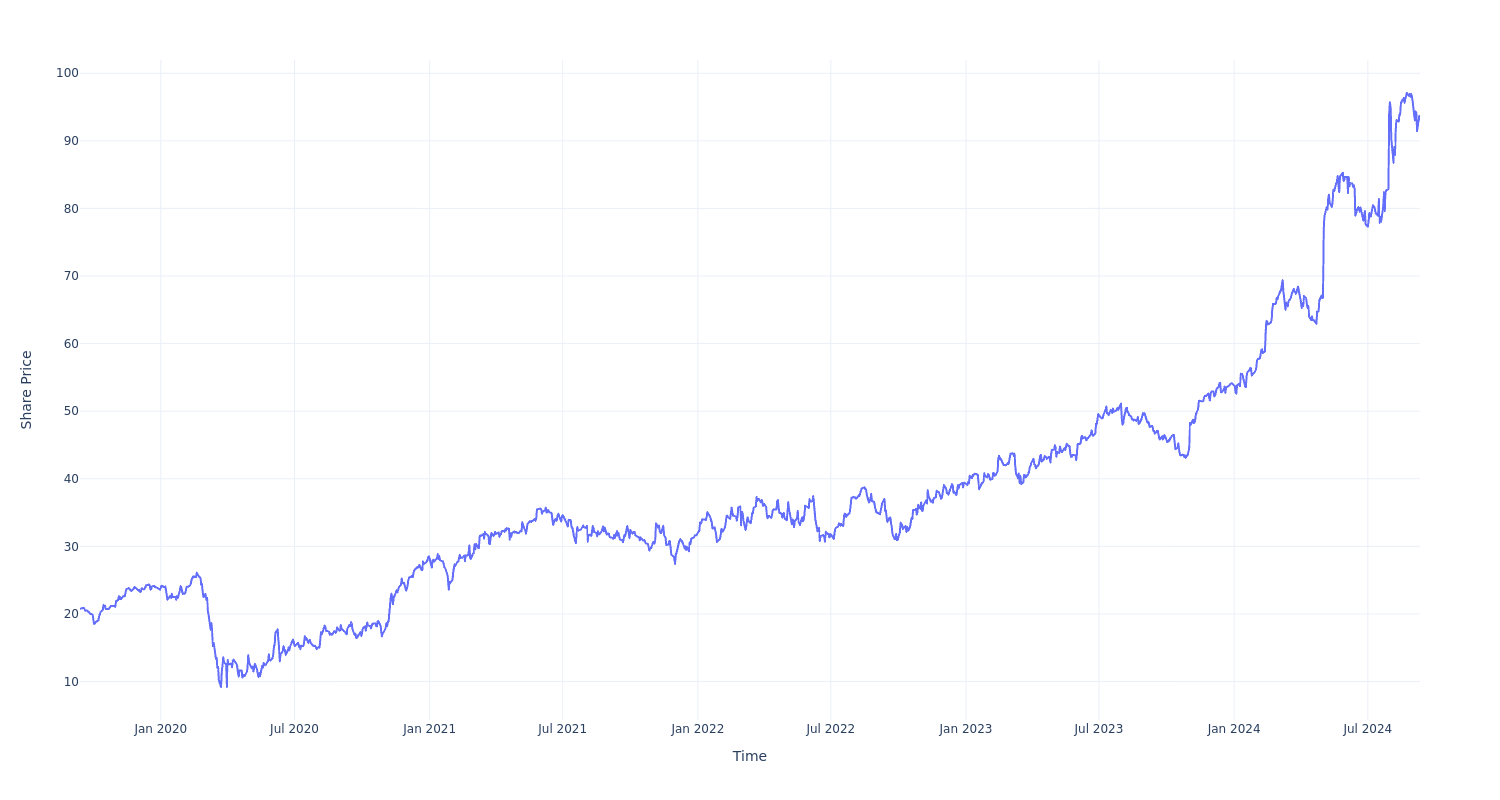
Finally — what’s the point of all this? The key insight to take from this article is to note how much of a difference compounded returns can make in your cash growth over a period of time.
This article was generated by Benzinga’s automated content engine and reviewed by an editor.
Market News and Data brought to you by Benzinga APIs
© 2024 Benzinga.com. Benzinga does not provide investment advice. All rights reserved.
Vanished Banker Loses $750 Million in China’s Unending Crackdown
(Bloomberg) — In the go-go years when China minted a billionaire every two days, banking rainmaker Bao Fan almost reached that milestone himself.
Most Read from Bloomberg
His skill in advising tech giants like Alibaba Group Holding Ltd. made him one of the country’s most sought-after financiers, helping him amass a fortune worth more than $800 million through his ownership stake in China Renaissance Holdings Ltd.
Bao’s career came crashing down last year when he vanished from public view after being detained by authorities amid a broader crackdown. The extent of his financial freefall was revealed Monday when Renaissance shares tumbled after a 17-month halt. His stake is now worth $55 million, down 93% from its peak in February 2021, based on a filing and calculations by the Bloomberg Billionaires Index. Bao beneficially owns a roughly 35% stake directly in the firm, through two holding vehicles and a trust.
A spokesperson for China Renaissance had no immediate comment when contacted by Bloomberg News.
Bao’s sudden comedown cast a pall on China’s financial sector, which has become a frequent target of President’s Xi Jinping’s “common prosperity” drive. More than a hundred financial executives and officials were ensnared in the anti-corruption push in 2023 alone, while bankers face pay cuts and belt-tightening to curb what officials consider “hedonistic” lifestyles.
“The lack of transparency about the reason why all of these financial sector stars — some of them not even stars — are detained is really not going to help the return of capital into China,” said Alicia Garcia Herrero, chief economist for Asia Pacific at Natixis.
The crackdowns and relentless job losses are forcing bankers to reconsider their careers, as they try to navigate Beijing’s dramatic shift to high-end manufacturing and renewables, and away from finance and real estate that drove China’s economy for decades.
Bao, 53, is one of the most high-profile losers to follow that pivot. The former banker at Morgan Stanley and Credit Suisse founded China Renaissance in 2005, making a name for himself after brokering mergers that led to the creation of ride-hailing service Didi Global Inc. and food-delivery giant Meituan.
His ability to spot rising tech stars made him one of China’s most influential bankers, persuading billionaire Jack Ma to become a cornerstone investor when his firm went public in 2018. He later branched into private equity to back startups and tech firms, managing more than $8.8 billion in assets at the end of 2020.
That all began to unravel when Bao was detained in February last year without any official explanation. China Renaissance said only that it had lost contact with him. He was later placed under detention for an unspecified investigation by Chinese authorities amid a broader sweep of the financial sector. Earlier this year, the former chairman and chief executive officer resigned “for health reasons and to spend more time on his family affairs,” according to a company statement.
The company offered no clues as to the founder’s whereabouts Monday when it released earnings that had been delayed for more than a year. His current legal status is unclear.
The turmoil has taken its toll on the business, which has also been hit by a slump in deals as China’s economy slips into a deflationary spiral. The company recorded a loss of nearly 74 million yuan ($10.4 million) in the six months to June as revenue dropped 39% to 329 million yuan. It posted a loss of 471.9 million yuan for all of 2023, the second year in a row in the red.
Almost a third of staff in Hong Kong, which includes investment banking, private equity and wealth management teams, either resigned or lost their jobs, Bloomberg News reported in February.
China Renaissance’s shares plunged 66% in Hong Kong Monday, its first day of trading since March last year, reducing the firm’s market value to HK$1.39 billion ($178 million).
Elsewhere, there were at least 130 investigations and penalizations of financial executives and officials in 2023 alone. China has appointed a new head to crack down on financial corruption, indicating the probes aren’t finished.
In the absence of Bao, the firm has pledged to “usher in a new era.”
“Despite all kinds of difficulties and challenges, China Renaissance still actively seeks growth and forges ahead with determination in the midst of adjustments,” according to the earnings report.
–With assistance from Pei Yi Mak, Cathy Chan and Lulu Yilun Chen.
Most Read from Bloomberg Businessweek
©2024 Bloomberg L.P.

